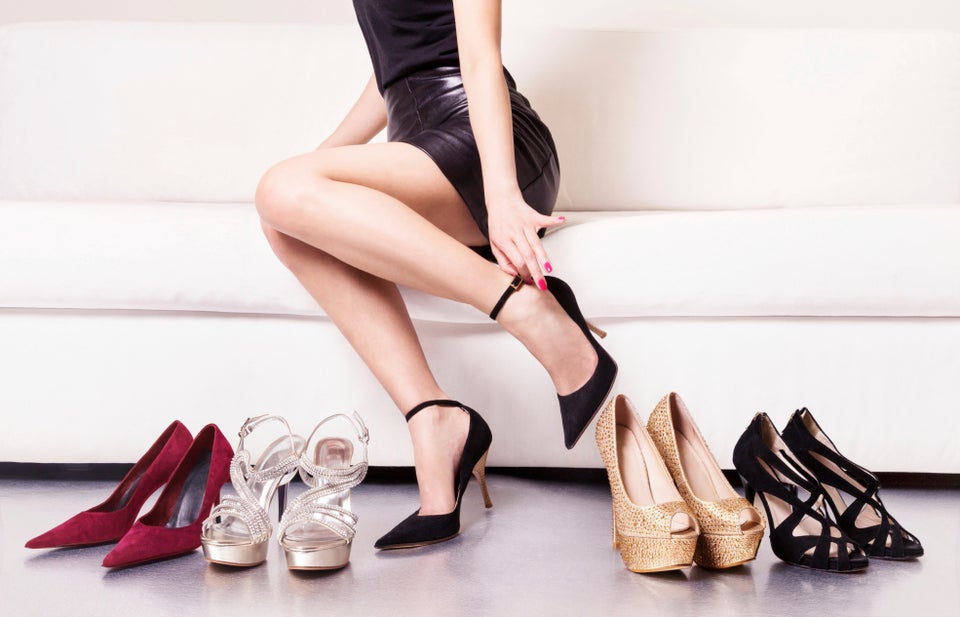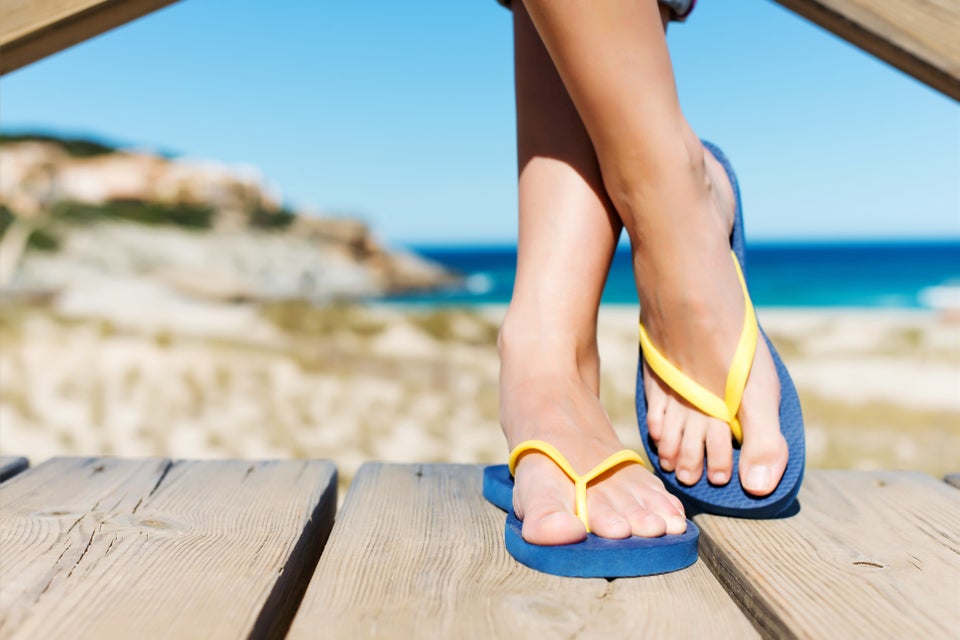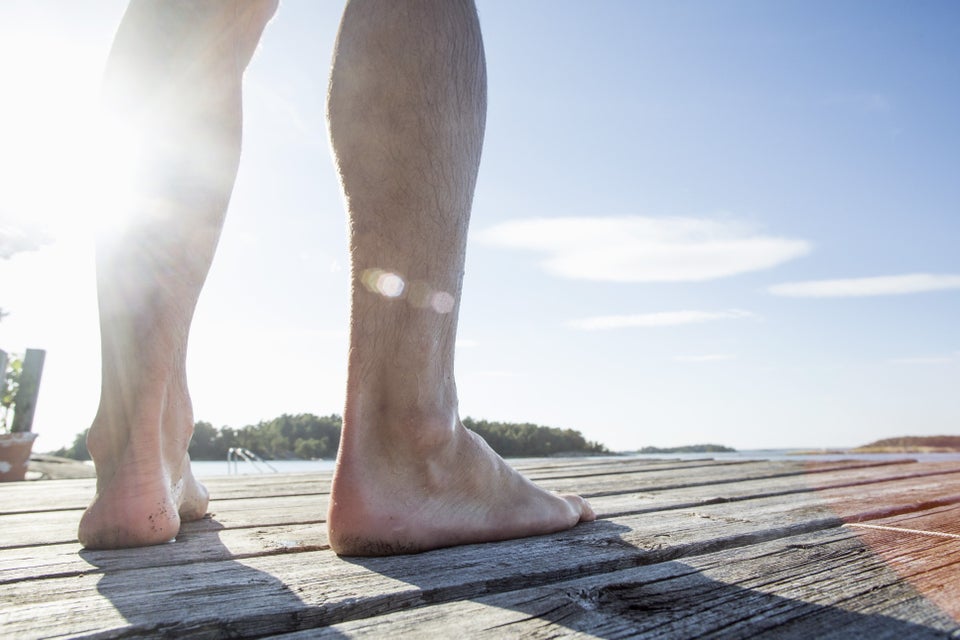
Doctors trying to get to the bottom of a person's heel pain may inadvertently cause their patients more injury if an examination doesn’t include an ultrasound, according to a new study.
It's estimated that about 10 percent of people will experience heel pain at least once in their lives. The most common cause of heel pain is plantar fasciitis, in which the ligament that connects the heel bone to the toes becomes inflamed. But other things -- like a tear in the ligament or a fatty cyst -- could be to blame, according to researcher Dr. Rock Positano, director of non-surgical foot and ankle service at the Hospital for Special Surgery in New York City.
“So many people are told that they have plantar fasciitis when they don't," Positano told The Huffington Post. "Heel pain is the great imitator, because so many things could cause it."
Positano and his fellow researchers looked back at the patient files of 143 people who came to the hospital's Joe Dimaggio Sports Foot and Ankle Center from 2006 to 2007, complaining of foot and heel pain in a total of 175 feet. The patients had all either been previously diagnosed with plantar fasciitis, or were clinically diagnosed with it after an examination at the center. Then their feet were examined with an ultrasound machine. Positano found that while the ultrasound confirmed plantar fasciitis in 73 percent of the feet, it also revealed ligament tears in 34 percent. The ultrasounds also found at least one plantar fibroma, or benign growth, in 15 percent of the feet.
The treatment for all three conditions can be very different, and in some cases even interfere with each other if a foot condition is misdiagnosed. Alternately, Positano explained, a person could have all three conditions in their foot but not know it because of the lack of an ultrasound examination.
“Sometimes I get a patient who has had heel pain for a year, and they were told to go stretch it,” said Positano. “So not only have they been treating it incorrectly, they’ve also now made it worse."
It usually takes about three to six weeks for the inflammation linked to plantar fasciitis to go down, but having a tear in the plantar fascia ligament or a growth in the foot may take anywhere from two to five months in recovery time. And stretching, which is a commonly-prescribed therapy for the treatment for plantar fasciitis, could even make the injury worse if the cause of the pain is actually a ligament tear. Ligament tears require lots of rest and sometimes even surgery, in extreme cases.
A plantar fibroma is also treated with surgery if other ways to alleviate foot pressure (such as a therapeutic insole) don’t reduce pain.
“Make sure that a diagnostic ultrasound is performed to assess what’s happening with the plantar fascia” when seeing a doctor about heel pain, advised Positano.
“Heel pain puts more stress on the other joints, like the knees, hips and back,” he concluded. “It’s not just the foot we’re talking about; were talking about everything else above it."
While plantar fibromas are generally thought to have a genetic cause, people can develop inflammation or tears in the plantar fascia ligament from wearing old shoes, shoes with no arch support, or using unsupportive shoes while exercising, Positano explained.
The study was published in the March/April edition of the Journal of the American Podiatric Medical Association.
Related
Before You Go

A new pair of sandals often comes at the steep price of painful blisters. The sores form from chafing that happens when a shoe rubs up against the skin until it balloons out, filling with fluid to cushion and protect the deeper layers of skin underneath, explains Jackie Sutera, a New York City podiatrist.
The first step for prevention, says Jane Andersen, a podiatrist in Chapel Hill, North Carolina and a spokesperson for the American Podiatric Medical Association, is to buy shoes that are comfortable when you buy them and don't need to be "broken in." Look for soft fabrics or leathers, and then take them for a test drive at home for an hour or so to make sure you stay pain-free before you wear them outside. You can also try lining any painful spots with moleskin to prevent the friction that ultimately causes blisters.
But sometimes, even seemingly comfy shoes can cause problems. "I've purchased perfectly good pairs of shoes that have given me blisters," Andersen says. If you do end up in pain, clean the blister with regular hand soap and try to leave it intact. But if the pain is unbearable, use an alcohol-sterilized needle to poke a tiny hole in the side of the blister and drain the fluid out, leaving all the skin intact. Then apply some antibiotic ointment and cover with a band-aid. (Don't try this at home if you're diabetic, though, Andersen cautions.)

Over-wearing this summertime staple can cause stress fractures, heel pain and tendonitis, and can exacerbate hammertoes. "These are not shoes that we should be wearing from 8 in the morning to 8 at night," Sutera says. "That's not really what these shoes are made for."
That said, they're hard to resist. And there are ways you can make flip flops a safer footwear choice.
"Not all flip flops are created equally," Sutera says. Look for a pair with a thicker sole with arch support -- and the more straps the better, as that can reduce the stress placed on the toes from gripping the flip flop so it doesn't fly off your foot. You shouldn't be able to bend the flip flop (or any shoe, for that matter), in half -- that's your first clue that it won't provide enough support. Reserve the ultra-thin ones for the locker room or pool.

Walking barefoot might be one of the great joys of summer, but it can also put you at an increased risk of contracting viruses like warts, fungus such as athlete's foot, or bacteria that can cause a skin infection, Andersen explains. These things tend to thrive in warm, moist environments, like a public pool.
Going shoeless also raises the risk of picking up foreign bodies, like stepping on glass or splinters.
Even walking around barefoot at home can be problematic, Andersen says, because the foot is left unsupported. If your house has a no-shoes rule, consider throwing on a pair of supportive slippers or indoor flip flops.

For some people, hot temps mean sweaty feet, and all that moisture can increase the risk picking up an infection. Andersen suggests wearing socks that wick excess moisture away, and changing out of damp socks as soon as possible. If you can't shower, at least rinse your feet off. "Keep a nice, cool environment for your feet," she says.
One natural trick? Brew regular black tea, let it cool and tuck your feet in for 30 minutes. Andersen says the tannins in the tea can decrease sweat production.

For many, polished toenails are a summertime necessity -- but serious health risks might be lurking in the pedicure chair.
"Pedicures can be a source for real problems," Andersen says. Everything from the tools to the relaxing whirlpool soak can transmit nail fungus, wart viruses and sometimes serious bacterial infections.
To stay safe, consider bringing your own tool set, Sutera says, especially the foot file, and clean your tools back home with a betadine solution. She also tells her patients to avoid the "Wednesday special," or a great deal that brings dozens more customers -- and germs -- through the salon. If possible, schedule your appointment at the beginning of the day, when technicians should be less tired and the tools and basins a little bit cleaner.
And don't shave or wax your legs for at least 24 hours before your appointment -- hair removal can cause microscopic cuts, increasing susceptibility to infection.

One study from the University of Miami and the "Today" show found that a single pair of flip flops can harbor a whopping 18,000 bacteria, including the dangerous superbug Staphylococcus aureus.
Walking the streets in open shoes can mean kicking up all sorts of debris, including human vomit, feces, bird droppings and a whole host of other unappetizing things, Phillip Tierno, director of clinical microbiology and immunology at the NYU Langone Medical Center, told The Huffington Post. Then you take your shoes off and touch, say, your face. "It's a repository for everything you brought in from the outside and [you] don't give it a second thought," he said.
A few simple precautions can keep you safe: Tierno recommends removing your shoes before entering the house and avoiding wall-to-wall carpeting when possible, as it can harbor germs. Slip on a pair of slippers at the end of the day and wash your hands thoroughly -- between 25 and 30 seconds -- after you remove your shoes.

Wearing open-backed shoes can spread the fat pad of the heel, causing the skin to crack, says Andersen. If you have any deep cracks where you can see dried blood, treat the heel with an antibiotic oil and cover with a band aid.
But if you just have run-of-the-mill dry summer heels, Sutera suggests treating them with an exfoliating moisturizer every day and run a pumice stone over them once or twice a week in the shower -- but only in one direction, as going back and forth can actually make the split skin worse.
Dry, cracked heels can also be a sign of a fungus, psoriasis, thyroid issues and diabetes, Sutera says. If you're concerned, visit a podiatrist or dermatologist to get the all clear.